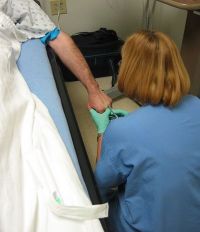According to a report by the researchers from the Johns Hopkins Armstrong Institute for Patient Safety and Quality, interventions focused on evidence-based infection prevention practices, safety culture and teamwork, and scheduled measurement of infection rates considerably reduced central line-associated bloodstream infections (CLABSIs) across intensive care units (ICUs) in seven Abu Dhabi hospitals. The results have been published in the journal Infection Control & Hospital Epidemiology.
This project was a collaborative effort between the Armstrong Institute, Johns Hopkins Medicine International and the Abu Dhabi Health Services Company (SEHA). ICUs involved in the project assembled a Comprehensive Unit-based Safety Program (CUSP) team that comprised of a local physician, nursing leaders, a senior executive, frontline healthcare providers, an infection control provider and hospital quality and safety leaders. There were 10 adult, five neonatal and three paediatric ICUs included in the program.
As part of the program, the CUSP teams implemented three interventions. These included efforts to prevent CLABSIs targeting clinicians' use of evidence-based infection prevention recommendations from the CDC; a CUSP process to improve teamwork and safety; and measurement of CLABSI data and feedback to ICU staff, leaders and safety teams.
At the completion of the program, there was a 38 percent reduction in infections in 18 ICUs. The number of units with a quarterly CLABSI rate of less than one infection per 1000 catheter days increased by nearly 40 percent. All hospitals showed significant improvements and were able to sustain them a year after the project was completed.
The CLABSI rate for participating ICUs decreased by 30 percent - from 2.56 infections per 1000 catheter days to 1.79 per 1000 catheter days. CLABSI rates decreased by 16 percent in adult ICUs, 48 percent in paediatric ICUs and 47 percent in neonatal ICUs. 61 percent of the ICUs achieved a quarterly CLABSI rate of less than one infection per 1000 catheter days as compared to 44 percent before the interventions.
According to lead author Asad Latif, MBBS, MD, MPH, an assistant professor of anaesthesiology and critical care medicine at the Johns Hopkins University School of Medicine, and a faculty member at the Armstrong Institute, “Our results suggest that ICUs in disparate settings around the world could use this program and achieve similar results, significantly reducing the global morbidity, mortality and excess costs associated with CLABSIs. In addition, this collaborative could serve as a model for future efforts to reduce other types of preventable medical harms in the Middle East and around the world.”
CLABSIs increase the length of stay, hospital costs, morbidity and mortality as highlighted by the senior study author Sean M. Bereholtz, MD, MHS, a professor of anaesthesiology and critical care medicine at the Johns Hopkins University School of Medicine. Hospitals around the world struggle to reduce CLABSI rates. The results achieved in Abu Dhabi build on the earlier efforts by patient safety experts at Johns Hopkins such as the Keystone ICU Project that resulted in a 66 percent reduction in CLABSIs across 103 Michigan ICUs. The project prompted spread of this program to more than 1000 ICUs in the US, the UK and Spain. The program implemented in the US and completed in 2012 reduced the rate of bloodstream infections in the ICUs by 40 percent saving more than 500 lives, preventing nearly 2000 bloodstream infections and saving $34 million in healthcare costs.
Source: Johns Hopkins Medicine
Image Credit: Wikimedia Commons



























